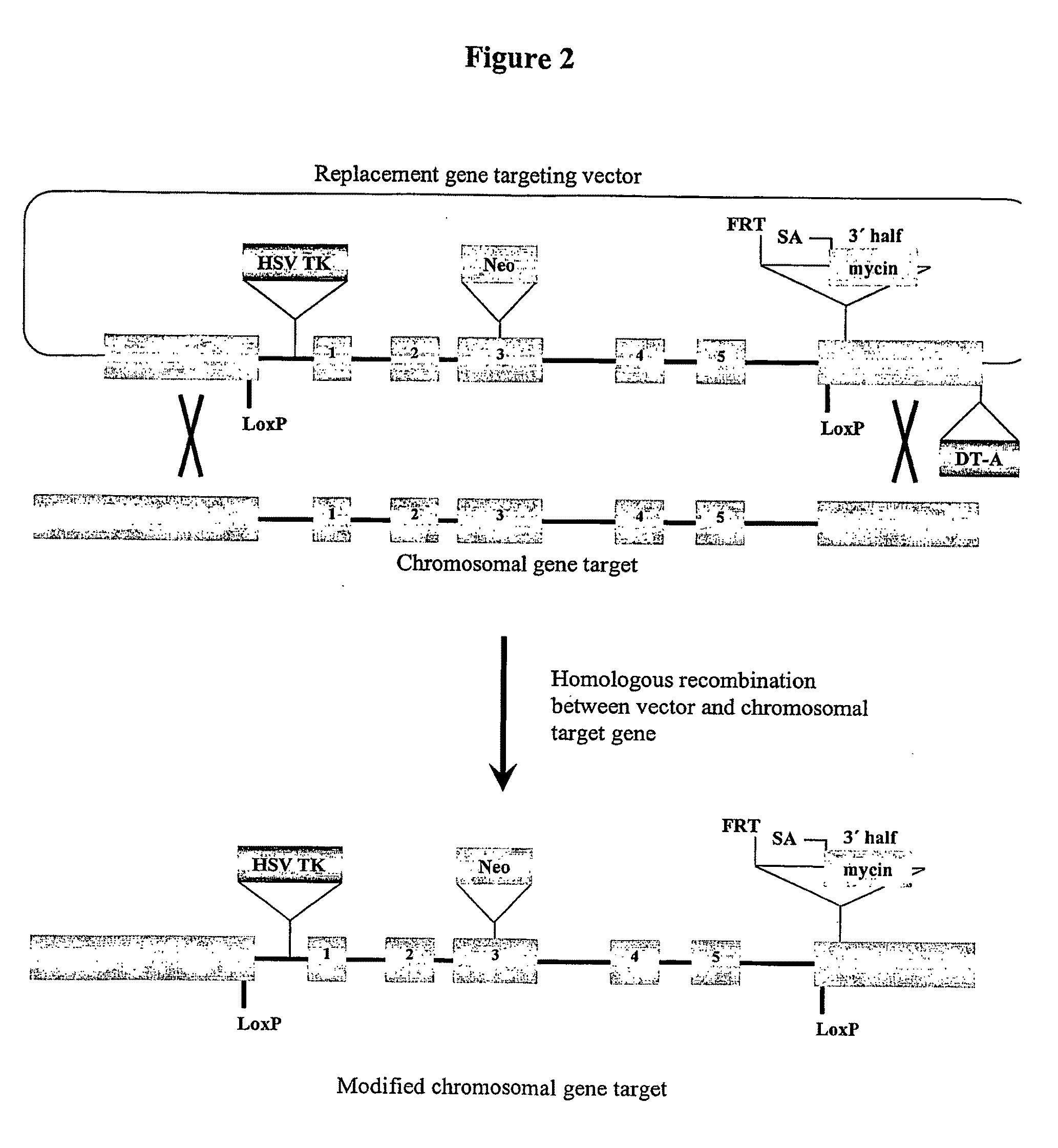Totipotent, Nearly Totipotent or Pluripotent Mammalian Cells Homozygous or Hemizygous for One or More Histocompatibility Antigent Genes
a technology of histocompatibility and mammalian cells, which is applied in the field of totipotent, nearly totipotent or pluripotent mammalian cells homozygous or hemizygous for one or more histocompatibility antigent genes, can solve the problems of unresolved histocompatibility problems, health risks to the organism, and unnecessary blood group compatibility, so as to reduce the complexity of mhc genes and reduce immunogenicity
- Summary
- Abstract
- Description
- Claims
- Application Information
AI Technical Summary
Benefits of technology
Problems solved by technology
Method used
Image
Examples
example 1
Engineering hES Cells for Homozygosity at the HLA-A Gene
[0134]Step 1: Gene Knockout of the HLA-A*010101 allele
[0135]Female human embryonic stem cells generated under GMP conditions under pathogen-free conditions with an O-ABO blood type (hES (O-)) are modified using a replacement type gene targeting vector similar in structure to that diagrammed in FIGS. 2 and 3. In this approach, homologous recombination between the targeting vector and its homologous chromosomal gene target introduces selectable gene markers and other gene changes into the target site. Other gene changes can include point mutations, insertions, and deletions that may inactivate or change the function of the target gene. The neomycin acetyl transferase gene that confers cell resistance to the drug G418 is included as a positive selectable marker to select for potential homologous recombinants. Other positive selectable markers can be gene expression cassettes that include genes encoding hygromycin phosphotransferas...
example 2
Inactivation of Both Cellular HLA-A Alleles Using Gene Targeting
[0147]Gene targeting may also be used to inactivate both sister copies of HLA-A. There are two gene targeting strategies used to generate sister knockouts, starting with the HLA-A knockout cell line illustrated in FIG. 3. One strategy is to construct a new gene targeting vector, replacing the Neo cassette with a new positive selection cassette, allowing positive drug selection for new homologous recombinants at the unmodified sister HLA-A allele. Co-selection of cells using both positive selectable markers ensures recovery of cells with both HLA-A alleles targeted. An alternative approach is to “recycle” the Neo drug resistance cassette, deleting the cassette by Cre mediated site specific recombination. To accomplish this, cells are transiently transfected with the Cre recombinase expression vector, and 5 to 7 days later put under selection with the drug Ganciclovir to select for cells missing the HSV TK gene. Cells del...
example 3
Deletion of HLA-C and HLA-B Using a Gapped Replacement Targeting Vector
[0148]While the objective of many gene targeting strategies is to modify one gene, gene targeting vectors are used to delete from a few basepairs to several kilobasepairs of chromosomal target genes. The approach is graphically illustrated in FIGS. 4 and 5. Essentially a conventional replacement style vector is used, although defined chromosomal target DNA sequences are deleted from the vector. A successful targeted gene modification produces cells with the corresponding deleted chromosomal sequences.
[0149]The HLA-C / HLA-D locus is illustrated in FIG. 5. The HLA-C and HLA-B structural genes are 4 to 5 kilobasepairs in size, separated by approximately 80 kilobasepairs of chromosomal DNA sequence. The sequence identities of HLA-C and HLA-B are defined in FIGS. 11 and 12. The chromosomal HLA-C and HLA-B genes are deleted using the targeting vector depicted in FIG. 5. In this approach, the targeting vector is missing ...
PUM
| Property | Measurement | Unit |
|---|---|---|
| concentration | aaaaa | aaaaa |
| concentration | aaaaa | aaaaa |
| concentration | aaaaa | aaaaa |
Abstract
Description
Claims
Application Information
 Login to View More
Login to View More - R&D
- Intellectual Property
- Life Sciences
- Materials
- Tech Scout
- Unparalleled Data Quality
- Higher Quality Content
- 60% Fewer Hallucinations
Browse by: Latest US Patents, China's latest patents, Technical Efficacy Thesaurus, Application Domain, Technology Topic, Popular Technical Reports.
© 2025 PatSnap. All rights reserved.Legal|Privacy policy|Modern Slavery Act Transparency Statement|Sitemap|About US| Contact US: help@patsnap.com



